10 Best Patient Engagement Tools | Improve Care & Trust
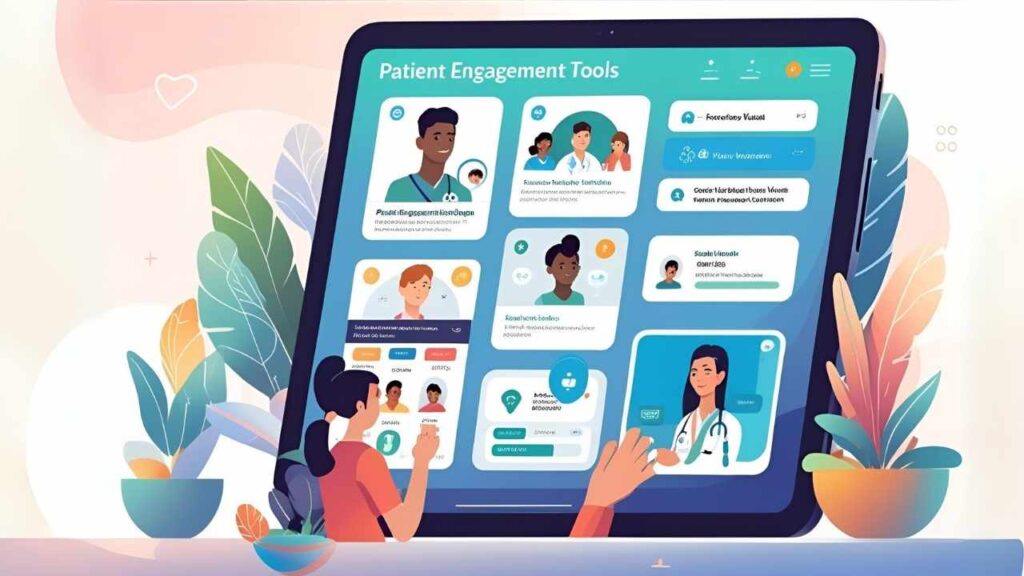
In the modern medical environment that is changing like wildfire today, it has become important to ensure that there is an opportunity to maintain a significant relationship with the patients. More providers are resorting to digital solutions as a way to streamline their communication, processes, and promote overall patient satisfaction.
Patient engagement technologies or patient engagement tools have become parameter-shattering technologies in that they fill the gap between the healthcare providers and the patients, providing automated systems linked to scheduling, communications, bills, and follow-ups. Such innovative platforms not only cut the costs of administration but also allow patients to participate in the process of healthcare more actively by providing the possibility of self-service, as well as timely communication channels.
What is Patient Engagement?
Patient engagement means the involvement of the patient in decision-making processes regarding the medicines used or the treatment plan, or the future health of the patient him or herself. It covers multiple touchpoints in the healthcare process, including appointment booking, follow-up, and post-treatment. The key to successful engagement is two-way communication between patients and medical care providers who feel listened to, informed, and able to make health decisions.
This process is made possible through modern patient engagement tools that offer digital platforms to allow easy communication, automatic reminders, and online appointment scheduling, as well as secure messaging between healthcare facilities and patients. The tools can help convert the traditional healthcare interactions into high-energy and friendly, and comfortable experiences that eventually result in improved health outcomes.
Why Patient Engagement Tools Are Important
The medical sector is confronted with more obstacles than everbeforere such as the shortage of personnel, the number of patients, and their growing demands for digital services. Patient engagement tools help address these issues by developing tools and solutions that are efficient and scalable to the benefit of providers and patients.
- Efficiency: The digital platforms make various processes that were cumbersome much more efficient and save staff workload because it is no longer necessary to perform hours of recurring scheduling activities compared to direct patient care.
- Communication: Dual-messaging features offer real-time communication, meaning that the two-way communication between patients and providers allows doing away with phone tag and increasing the responsiveness to urgent issues.
- Satisfaction: Automated and self-service features allow patients to get reminders about their scheduled appointment and give them a high level of convenience and flexibility in their healthcare experience, which is expected in contemporary healthcare.
- Outcomes: Steady follow-up and educational messages and materials maintain patients attentive to treatment plans and results in better health outcomes.
- Revenue: Lower no-show rates and simplified billing, therefore, translate to more revenue practice and less associated (administrative and collection) overhead.
Essential Features to Look for in Patient Engagement Tools
When considering a patient engagement tool, service providers ought to focus on the features that will suit their target practice needs and patient demographics, as well as aligning it with regulatory requirements in healthcare.
- Integration: Fluent interfacing with pre-existing EHR systems not only provides data consistency but also (relatively speaking) eliminates the possibility of separate data entry, as duplication of data is highly unlikely in this case and also, in any case, makes up a complete picture of the patient.
- Automation: Intelligent scheduling, reminders, and follow-ups minimize manual workload and guarantee constant contact with the patients without oversaturation of the staffing resources.
- Security: HIPAA-compliant messaging and data storage ensure sensitive information of patients is secured and allow a secure way of communication to occur between the provider and the patient.
- Multichannel: Both needs-based and access-based patient diversity is supported by the support of various communication channels such as text, email, voice, and web chat.
- Analytics: It offers a full set of reporting and tracking features that allow practices to view patient engagement analytics so that they can fine-tune their messaging strategies and gauge success.
Comparison Table for Patient Engagement Tools
| Tool Name | Rating | Best Feature |
| Klara | 4.5/5 | Phone-to-text conversion with unified messaging |
| Artera | 4.7/5 | AI-driven virtual agents with 109 language support |
| TeleVox | 4.3/5 | SMART Agent technology for two-way conversations |
| Phreesia | 4.2/5 | Complete patient journey automation |
| NexHealth | 4.4/5 | Robust EHR integration with real-time sync |
| Tebra | 4.1/5 | All-in-one platform connecting 130+ healthcare systems |
| Solutionreach | 4.0/5 | Exceptional no-show rate reduction |
| ModMed | 4.3/5 | AI-powered specialty practice workflows |
| DoctorConnect | 4.2/5 | Comprehensive engagement suite with telehealth |
| CipherHealth | 4.4/5 | Personalized care journey coordination |
10 Best Patient Engagement Tools
1. Klara
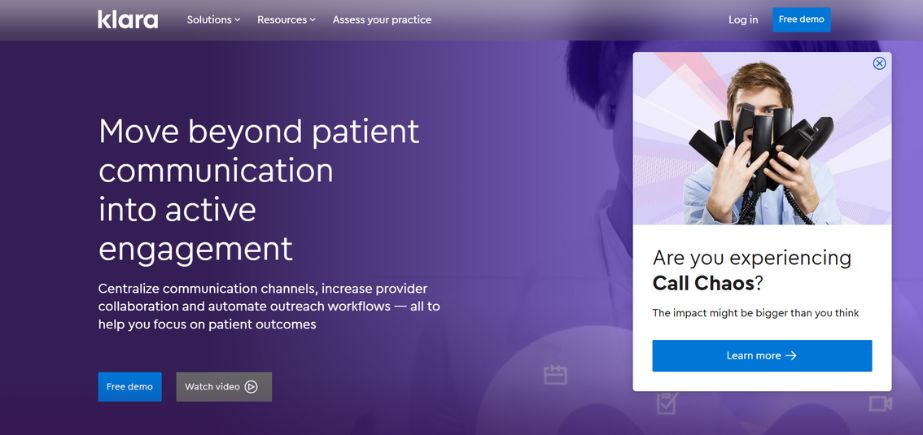
Rating: 4.5/5
Website: https://www.klara.com/
Best Use Cases: Medical practices seeking a unified communication platform to reduce phone volume
Klara is changing the face of healthcare communication by changing the old phone-based communication process with simplified messaging via text messages. The platform is excellent in utilisation of minimal phone time by staff, and secure communications, which are HIPAA compliant.
The most prominent aspect of it is that it renders phone calls through text messages, which enables patients to communicate without downloading any applications or even registering for an account. Also, Klara is well-suited to practice working on many electronic health record systems, as it easily integrates with the most popular systems, such as AdvancedMD and Veradigm.
The interface is friendly and does not need a lot of patient learning curve, coupled with advanced communication management tools for the healthcare staff. There is also the voicemail transcription and direct pharmacy connection to increase efficiency.
Key Features
- Call-to-text conversion
- Voicemail transcription capabilities
- EHR system integration
- HIPAA-compliant messaging platform
- No-app patient access
Pros
- Reduces phone time
- User-friendly interface design
- App-free patient experience
Cons
- Message history limitations
- Voicemail transcription accuracy
- Spam message confusion
Pricing: Contact for custom quotes
2. Artera
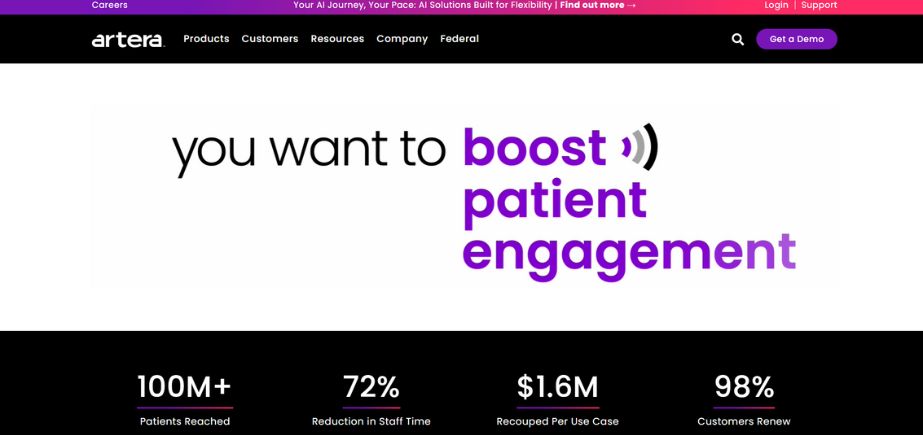
Rating: 4.7/5
Website: https://artera.io/
Best Use Cases: Healthcare organizations needing multilingual AI-powered patient communication solutions
Artera is positioned to conquer the patient engagement tools market because of its advanced use of AI within its healthcare communication schedule. Virtual agents are deployed on the platform that can interact both via voice and text channels for the complex cases of patients.
With 109 presets, Artera goes in line with the various changing language requirements of contemporary healthcare procedures. The potential uses of natural language processing allow automatic translation and conversion of summaries, which removes a lot of the workload of the staff and at the same time enhances response accuracy.
The implementation flexibility of the platform allows considering plans according to readiness to implement AI, which is why it will apply both to the practice at the initial stage of digital transformation and to the practice at the advanced stage of it. Pre-validated healthcare processes are guaranteed to comply and are efficient across a breadth of specialties and practice volumes.
Key Features
- AI virtual agent technology
- 109 language support
- Voice and text communication
- Natural language processing
- Automated workflow validation
Pros
- Multilingual communication support
- Flexible implementation approaches
- High customer retention
Cons
- Requires digital transformation investment
- Implementation of staff training needs
- Complex solution options
Pricing: Custom pricing based on practice size
3. TeleVox
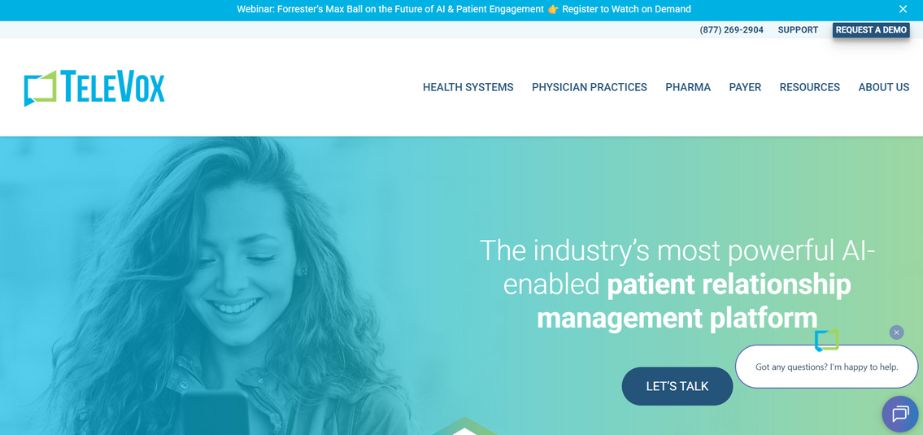
Rating: 4.3/5
Website: https://televox.com/
Best Use Cases: Healthcare enterprises requiring comprehensive automated patient relationship management
TeleVox has a multi-faceted patient engagement utilizing a SMART Agent technology where they have real two-way communication that exists between patients and artificial agents. The platform is best suited to handle complicated interactions with patients, such as booking, payment collection, and answering questions with the patients in one conversation.
Various channels of communication, such as text messaging, voice, email, and postcard, provide versatile outreach systems to different patients. Live response tracking is accompanied by built-in reporting so that strategy changes and effectiveness can be measured in real time.
The advantage of the platform is the ability to minimize the number of no-show appointments and provide self-service options of management options. It is also enabled with multi-language support as well as its on-demand broadcast messaging, which makes it appropriate when used by medical organisations with multicultural patient demographics.
Key Features
- SMART Agent conversational AI
- Multi-channel communication options
- Live response tracking
- Self-service appointment management
- Broadcast messaging capabilities
Pros
- Two-way conversation capabilities
- Reduces appointment no-shows
- Strong customer support
Cons
- Interface learning curve
- Limited customization granularity
- EHR integration complexity
Pricing: Tiered pricing based on patient volume
You may want to read: Best Risk Management Software
4. Phreesia
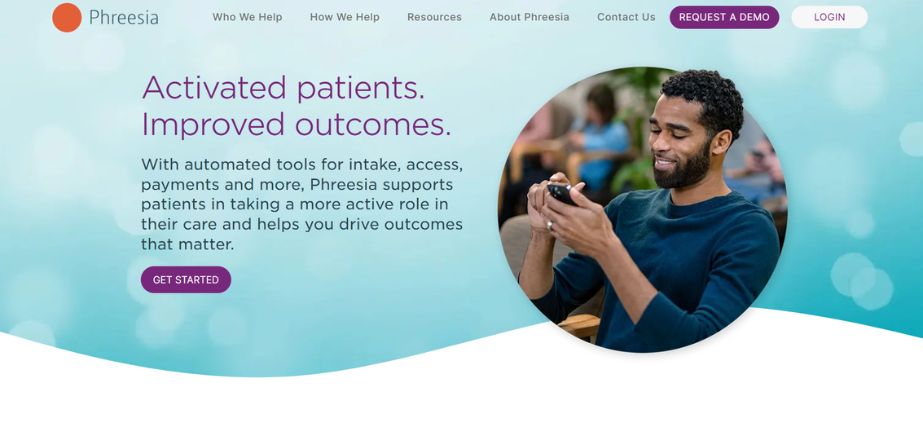
Rating: 4.2/5
Website: https://www.phreesia.com/
Best Use Cases: High-volume healthcare providers with limited staff seeking comprehensive automation
The service offered by Phreesia satisfies the peculiarities of healthcare providers who have to handle a large number of patients and are short of personnel. The platform integrates patient contact, online scheduling, online appointment reminding, payments, and patient reach in one complete solution.
Automated billing verification and payment collection increase the accuracy of billing and lessen administrative costs. The platform also fills in service gaps because it connects to the current systems and services the entire patient life cycle, a s the premises before visiting the actual event to follow-up visits.
Cardiology-specific, OB/GYN workflows, among others, make sure that various types of practices are taken care of by having the content that applies to the given specialty. The human-oriented work style preserves personal touch yet uses automation to make operations work according to schedule.
Key Features
- Complete patient journey support
- Automated benefits verification
- Specialty-specific workflows
- Payment collection automation
- Pre and post-visit management
Pros
- Comprehensive journey coverage
- Reduces staffing expenses
- Tailored specialty workflows
Cons
- Onboarding process complexity
- Cluttered interface without training
- Manual steps remain
Pricing: Subscription-based with implementation fees
5. NexHealth
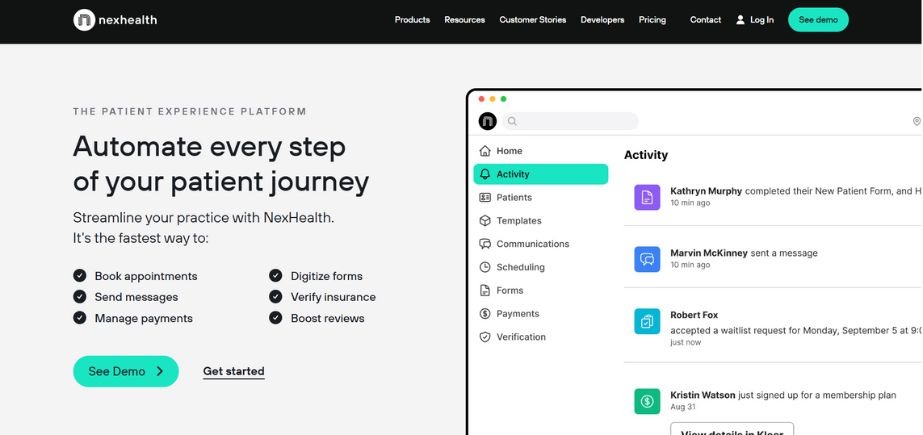
Rating: 4.4/5
Website: https://www.nexhealth.com/
Best Use Cases: Dental and medical practices prioritizing text-based digital patient experiences
NexHealth prides itself on its ability to design a smooth digitalized patient experience with text-based interaction and a fully integrated practice management experience. Its interface automatically syncs with the historical and new patient data in real-time, and this will negate the need for manual data entry points.
The functionalities of patient engagement cover various areas with five modules that solve the following issues, such as communications, scheduling, payments, and outreach campaigns. High levels of integration capabilities will make it compatible with whatever existing management system is being used without inconsistency of data between systems.
Constant touch points of engagement with patients are made by automated appointment reminders, recall messages, and requests to provide feedback regarding appointments. The platform is the strength because it is able to revolutionize the traditional ways of practice into simplified digital processes that not only increase patient satisfaction but also the efficiency of operations.
Key Features
- Real-time data synchronization
- Two-way HIPAA-compliant texting
- Online scheduling integration
- Automated feedback collection
- Insurance eligibility verification
Pros
- Robust EHR integration
- Automated reminder systems
- Self-service patient portal
Cons
- Appointment reminder timing issues
- 45-minute sync delays
- Limited image messaging
Pricing: starts at $299 per month
Also Read:
6. Tebra
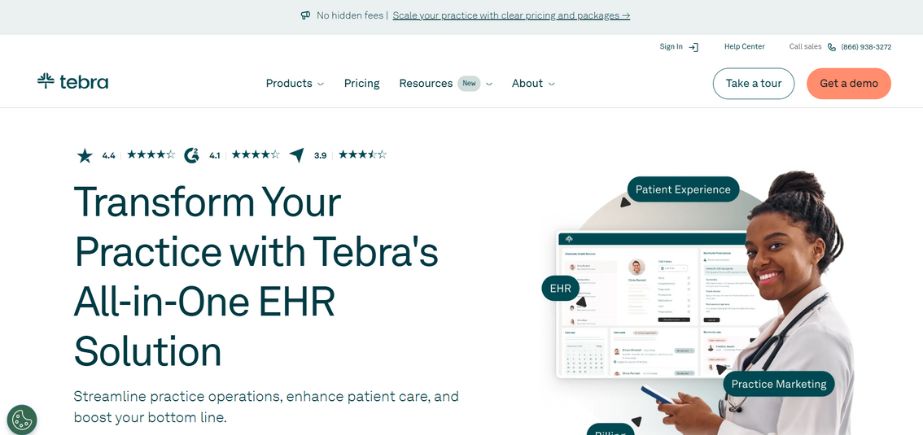
Rating: 4.1/5
Website: https://www.tebra.com/
Best Use Cases: Independent practices and billing companies needing a unified EHR platform
Tebra offers itself as the all-in-one single platform that connects healthcare providers with more than 130 various healthcare systems and services. The integrated interface brings together electronic health records, revenue cycle management, scheduling of patients, prescriptions, invoicing, and insurance claims to one accessible interface.
Its comprehensive connectivity does not mandate the usage of numerous software solutions and, at the same time, promotes the smooth data flow with various healthcare systems. Digital transformation is made through the platform’s ability to assist practices in migrating to digital records by converting physical files to digital files without losing security and HIPAA compliance.
Admin burden is reduced with patient self-scheduling and online intake forms, as it offers easy access to their choice of time to visit. The price, which consists of no contract and lower upfront costs, allows the model to be available to practices of any size.
Key Features
- 130+ healthcare system connections
- Unified EHR and billing
- Digital file conversion
- Self-scheduling capabilities
- Contract-free implementation
Pros
- Comprehensive system integration
- User-friendly interface design
- No contract requirements
Cons
- System outage risks
- Billing cycle problems
- Medication management limitations
Pricing: $150,000 to $450,000 for initial setup, plus $80,000 to $220,000 annually
7. Solutionreach
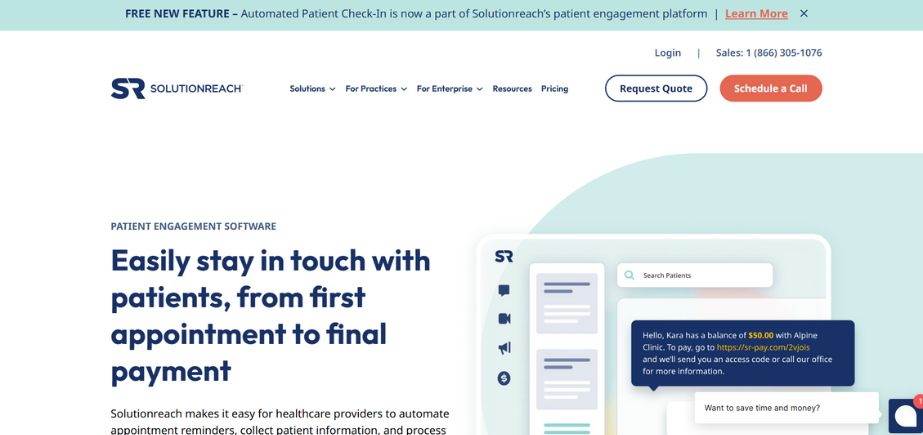
Rating: 4.0/5
Website: https://www.solutionreach.com/
Best Use Cases: Healthcare providers focused on dramatically reducing appointment no-show rates
Solutionreach focuses on resolving another problem of healthcare, which is chronic and recurring appointment no-shows. This universal solution, which integrates automated appointment-reminder capabilities with the use of real-time texting to collect insurance information and book appointments, has proven to be the ultimate source of information that auto insurance companies had to find.
The key to efficient mass communication is the use of batch messaging to assist announcements that can be made to the practice or seasonal health reminders. The platform supports different types of practices, e.g,. Dental, vision, and medical offices have custom message templates and scheduling possibilities. The implementation process usually takes place within a week, and the effect it has on the running of the current practice is minimal.
By concentrating on cutting menial administrative employment, healthcare personnel are in a position to be focused on direct patient care and satisfaction programs and ensure the stability of patient engagement.
Key Features
- Automated appointment reminders
- Real-time texting capabilities
- Batch messaging functionality
- Multi-practice type support
- Rapid one-week implementation
Pros
- Effective no-show reduction
- Quick implementation process
- Multi-specialty compatibility
Cons
- Inconsistent customer support
- Reliability operational issues
- Patient reminder overload
Pricing: Per-provider monthly fees
8. ModMed
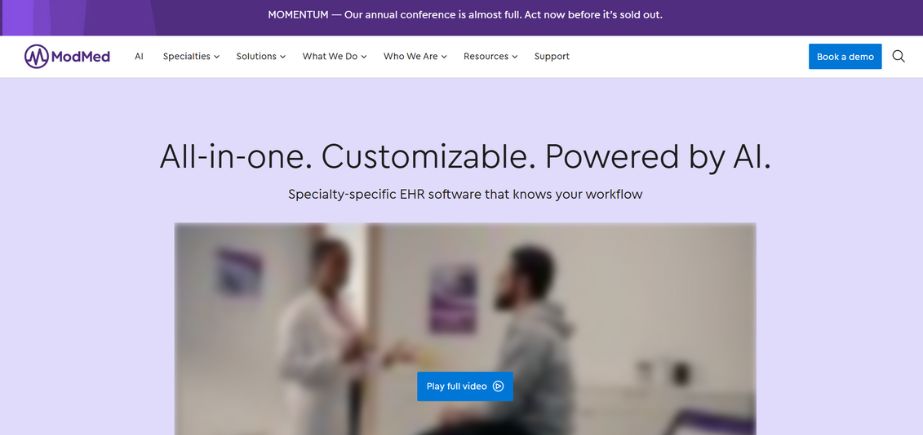
Rating: 4.3/5
Website: https://www.modmed.com/
Best Use Cases: Specialty healthcare practices requiring AI-driven clinical workflow automation
ModMed is one of the companies taking advantage of responsible artificial intelligence technology to improve healthcare delivery by providing specific practice-based solutions. The system is at its best in automating the time lag on clinical documentation as well as follow-up communications with intelligence. ModMed was created with specialty practices in mind and provides specialized workflows to attend to specialty requirements. Clinical documentation based on AI, automated messaging, and full analytics allows providers to allocate more time to direct patient care instead of clerical work.
Its combination with the EHR system offered by ModMed provides a harmonious environment in which all patient engagement tools are integrated. The interface design is clear, giving ease of navigation to the healthcare staff and patients, a nd yet has complex functionality in the background.
Key Features
- AI-powered clinical documentation
- Specialty-specific workflows
- Integrated EHR system
- Automated messaging capabilities
- Analytics and reporting
Pros
- Reduces documentation time
- Clean interface design
- Specialty practice optimization
Cons
- Limited general practice use
- AI suggestions require review
- Higher pricing structure
Pricing: starting price of $500 per provider, per month
9. DoctorConnect
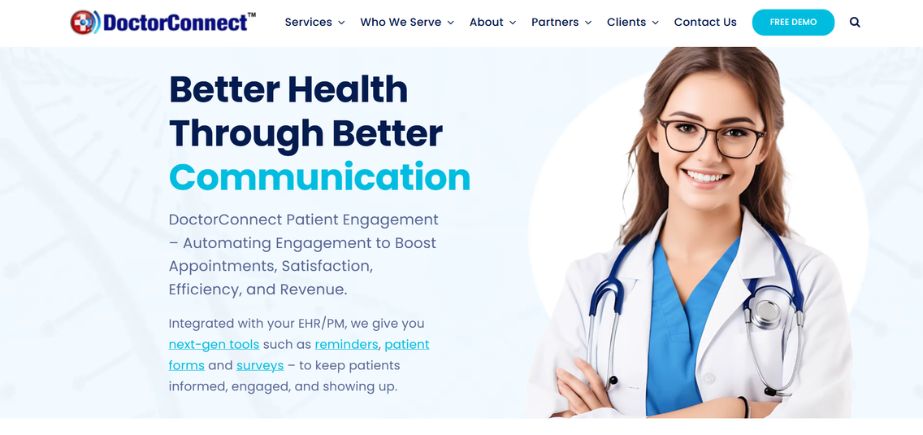
Rating: 4.2/5
Website: https://doctorconnect.net/
Best Use Cases: Medical practices seeking a comprehensive engagement suite with telehealth integration
DoctorConnect offers an all-in-one platform or set of patient engagement tools that is structured to be compatible with existing healthcare technologies and systems to be rapidly and easily deployed with little to no downtime to ensure healthcare systems disruption or downtime.
The platform concentrates on the key practice management challenges, such as the reduction of no-shows and optimization of patient scheduling, as well as digital form management. They are used to automate communication systems to take care of patient outreach and follow-ups at various touchpoints during the healthcare process. Telehealth appointment capability is responsive to contemporary healthcare provision in that it has retained the connected communication links.
HIPAA-compliant secure messaging options are available so that the process of patient-provider communication is convenient. Patient satisfaction surveys and recall systems are built into the system, which gives useful feedback mechanisms on continuous practice improvement and patient retention.
Key Features
- EMR system integration
- Telehealth appointment functionality
- Automated no-show management
- Secure messaging options
- Patient satisfaction surveys
Pros
- Easy EMR integration
- Telehealth capabilities inclusion
- Built-in recall system
Cons
- Staff training requirements
- Limited customization options
- Unclear pricing structure
Pricing: starting price around $210 per month
10. CipherHealth
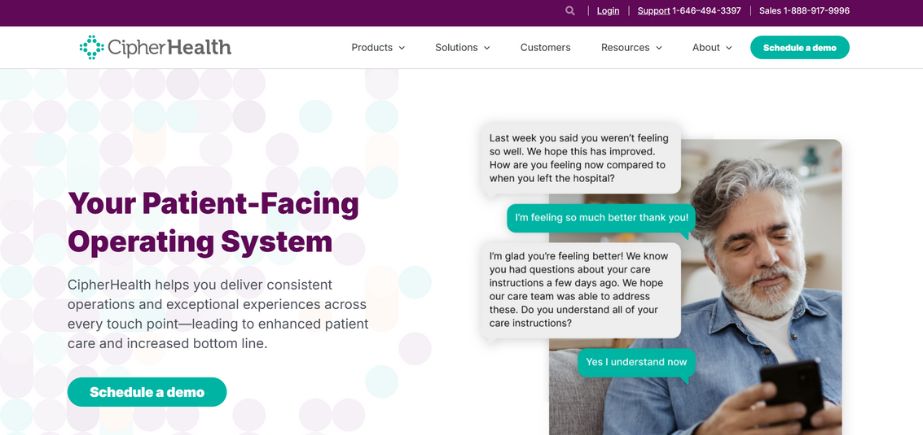
Rating: 4.4/5
Website: https://cipherhealth.com/
Best Use Cases: Healthcare providers focusing on personalized patient journey coordination and readmission prevention
CipherHealth offers personalized patient support through the full patient lifecycle and is especially successful in efforts to coordinate care of at-home patients. The platform integrates the communication systems between the patient and the staff to provide a widely coordinated care that is necessary in various healthcare environments and care providers.
Patient outreach and digital rounding capabilities based on technology allow patients to be heard in matters related to their care experience and also offer knowledge to the healthcare organizations involved. Proven scripts of customizable workflows allow customized care strategies for various patient groups and conditions.
The emphasis here is on the area of preventing hospital readmissions because of the second-order engagement with patients, which is why it is especially beneficial to operate hospitals and health systems that deal with complex populations. The ability to analyze trends and progress and follow up on them helps make it actionable to achieve constant improvement.
Key Features
- Digital rounding tools
- Patient outreach capabilities
- Customizable workflow scripts
- Readmission prevention focus
- Trend analysis tracking
Pros
- Reliable system performance
- Prevents hospital readmissions
- Strong technical support
Cons
- Navigation complexity issues
- Discharged patient roster problems
- Interface intuitiveness needs improvement
Pricing: starts at a baseline of $2,500 monthly
How to Choose the Right Patient Engagement Tools
When it is necessary to choose the best patient engagement tools, it is vital to consider your personal needs and the characteristics of your practice, as well as patient demographics and technological expertise. The decision-making must involve several stakeholders and investigate the possible solutions.
- Evaluation: Have your team evaluate present patient communications issues, staff processes, and technology resources through an in-depth audit.
- Integration: Consideration of integration of potential solutions to the current EHR, practice management software, and billing platforms. Uninterrupted integration leads to data consistency and the avoidance of disruption of the workflow.
- Scalability: Select patient engagement tools that can expand with the needs of the practice and as volumes of patients grow.
- Training: Think about the necessary learning curve, which both staff and patients need to obtain proficiency in new patient engagement tools.
- Compliance: All patient engagement tools should comply with HIPAA requirements and other possible healthcare regulations.
Conclusion
Healthcare is a sector that is constantly transforming and progressing in terms of the delivery of patient-centered care with a more digital approach, which is why patient engagement tools are now the key to contemporary healthcare. Such advanced platforms present opportunities like never before to maximize patient satisfaction, minimize administrative overheads, and improve health by effectively communicating consistently and on a personal and customized level. The current tools used to engage patients with AI-driven virtual agents and full workflow automation facilitate scalable solutions, helping to meet the varying practice demands and patient preferences.
Effective use of such platforms should be deliberate, pre-determined by the needs of the individual practices, support staff, as well as optimized on the basis of monitoring various performance indicators. Since more and more healthcare providers understand the importance of patient engagement via digital tools, they are becoming more progressive and innovative in offering new solutions regarding the development of better patient-provider relationships and exceptional healthcare experiences.
Frequently Asked Questions
Q: In what are patient engagement tools, and how do they work?
Patient engagement tools have been defined as digital platforms that enable the communication between patients and health care providers through automatic correspondence, online booking, payment, and other interactive options aimed at enhancing the overall health care experience.
Q: What are the costs of patient engagement tools?
Pricing is highly dependent on the size of practice, features needed, and ease of implementation, costing anywhere between 50-500+ dollars a month per provider, and many vendors custom price per specific need and patient volume.
Q: Are engagement tools in the patient HIPAA compliant?
Quality patient engagement solutions focused on addressing HIPAA requirements feature safe messaging, data encryption, audit log, and adequate privacy, so it is best to verify them before using them with a practice.
Q: What is the length of the implementation of patient engagement tools?
According to the complexity of the system, integration needs, training of the staff, and the size of the practice, implementations that range from one week to many months have been reported during the practice. Most systems provide dedicated assistance during the implementation process.
Q: Are patient engagement tools compatible with the current EHR systems?
The majority of available tools used to engage the patient in modern times provide options to integrate into existing popular EHR systems, but it is important to note that types of integration are different, with varying degrees of difficulty according to different systems and different platforms.